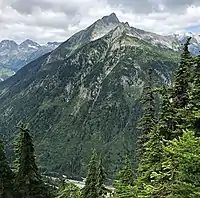| Cheops Mountain | |
|---|---|
 Cheops Mountain seen from Abbott Ridge | |
| Highest point | |
| Elevation | 2,581 m (8,468 ft)[1] |
| Prominence | 551 m (1,808 ft)[1] |
| Parent peak | Ursus Major Mountain (2705 m)[1] |
| Listing | Mountains of British Columbia |
| Coordinates | 51°16′59″N 117°33′07″W / 51.28306°N 117.55194°W[2] |
| Geography | |
 Cheops Mountain Location of Cheops Mountain in British Columbia  Cheops Mountain Cheops Mountain (Canada) | |
| Location | Glacier National Park British Columbia, Canada |
| District | Kootenay Land District |
| Parent range | Hermit Range, Selkirk Mountains[3] |
| Topo map | NTS 82N5 Glacier [2] |
| Climbing | |
| First ascent | 1893 Samuel E.S. Allen, Walter D. Wilcox[1] |
| Easiest route | Trail to Balu Pass, then Scrambling YDS 3[1] |
Cheops Mountain, is a 2,581-metre (8,468-foot) mountain summit located in Glacier National Park in the Selkirk Mountains of British Columbia, Canada. Cheops Mountain is situated in the Hermit Range, and the summit provides a good view of the Hermit and Sir Donald Ranges. Its nearest higher peak is Ursus Major Mountain, 4.0 km (2.5 mi) to the northwest.[1] Cheops is visible from Highway 1, the Trans-Canada Highway at Rogers Pass.
History
The first ascent of the mountain was made in 1893 by Samuel E. S. Allen and Walter D. Wilcox.[1]
The 1910 Rogers Pass avalanche was the deadliest avalanche in Canadian history, resulting in the deaths of 62 Canadian Pacific Railway workers.[4][5] In the late afternoon of March 4, 1910, an avalanche swept down the slopes of Cheops, burying the railroad tracks in snow. The men were working to clear the tracks when shortly before midnight the deadly slide hit, coming from the opposite side of the valley down Avalanche Mountain.
The mountain's current name was officially adopted in 1951 when approved by the Geographical Names Board of Canada.[2] Prior to that it was known as Mount Cheops. The peak was named by Otto Julius Klotz for its resemblance to the Pyramid of Cheops.[6]
Climate
Based on the Köppen climate classification, Cheops Mountain has a subarctic climate with cold, snowy winters, and mild summers.[7] Winter temperatures can drop below −20 °C with wind chill factors below −30 °C. Precipitation runoff from the mountain drains into the Illecillewaet River.
See also

References
- 1 2 3 4 5 6 7 "Cheops Mountain". Bivouac.com. Retrieved 2019-03-27.
- 1 2 3 "Cheops Mountain". Geographical Names Data Base. Natural Resources Canada. Retrieved 2019-03-27.
- ↑ "Cheops Mountain, British Columbia". Peakbagger.com. Retrieved 2021-04-11.
- ↑ "Rogers Pass a History of the Canadian Pacific Railway and Trans-Canada Highway crossing". cdnrail.railfan.net. Retrieved 2016-05-09.
- ↑ "Remembering the March 4, 1910 Avalanche at Rogers Pass". Revelstoke Museum & Archives. Retrieved 2021-04-11.
- ↑ "Cheops Mountain". BC Geographical Names. Retrieved 2021-04-11.
- ↑ Peel, M. C.; Finlayson, B. L.; McMahon, T. A. (2007). "Updated world map of the Köppen−Geiger climate classification". Hydrol. Earth Syst. Sci. 11 (5): 1633–1644. Bibcode:2007HESS...11.1633P. doi:10.5194/hess-11-1633-2007. ISSN 1027-5606. S2CID 9654551.
External links
- Weather: Cheops Mountain
- 1910 postcard image of Cheops Mountain: University of Alberta